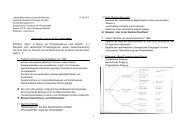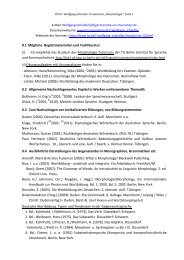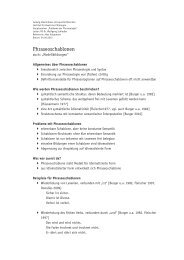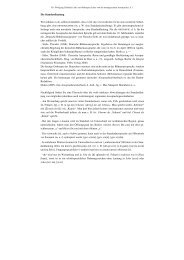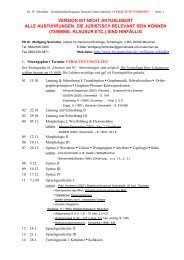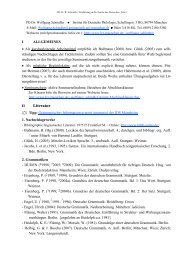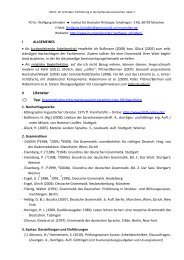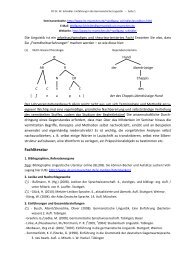Chapter 18 Lexical Functions: Description of Lexical Relations in a ...
Chapter 18 Lexical Functions: Description of Lexical Relations in a ...
Chapter 18 Lexical Functions: Description of Lexical Relations in a ...
You also want an ePaper? Increase the reach of your titles
YUMPU automatically turns print PDFs into web optimized ePapers that Google loves.
—<strong>Chapter</strong> <strong>18</strong>. <strong>Lexical</strong> <strong>Functions</strong>— 69<br />
• proliferation <strong>of</strong> common elements <strong>in</strong> the values <strong>of</strong> f for different keywords, which leads to<br />
the necessity <strong>of</strong> generaliz<strong>in</strong>g them.<br />
Let us take these two problems <strong>in</strong> turn.<br />
5.1. Elements <strong>of</strong> the Value f(L) as Subentries with<strong>in</strong> L’s Entry<br />
Logically speak<strong>in</strong>g, an element L´ <strong>in</strong> the value <strong>of</strong> the LF f(L) can itself be an LU <strong>of</strong> lan-<br />
guage L and have a lexical entry <strong>of</strong> its own, where its properties are fully specified. Yet it is also<br />
quite possible, and it actually happens more <strong>of</strong>ten than not, that as (an element <strong>of</strong>) the value <strong>of</strong> a<br />
particular LF f(L1), this L´ possesses some properties concern<strong>in</strong>g, e.g., its Government Pattern [=<br />
GP] or even its <strong>in</strong>flection, which it does not possess as an element <strong>of</strong> the value <strong>of</strong> f(L2) or g(L1)<br />
or else as a ‘free’ LU. The observable peculiarities <strong>of</strong> L´ are phraseological; they do not, strictly<br />
speak<strong>in</strong>g, accrue to L´ as such, but are due to its be<strong>in</strong>g part <strong>of</strong> the collocation L´ + L. These pecu-<br />
liarities must be <strong>in</strong>dicated <strong>in</strong> the lexical entry <strong>of</strong> L—where L´ itself is specified. This means that<br />
an element L´ <strong>of</strong> the value f(L) <strong>of</strong> the LF f given <strong>in</strong> the entry <strong>of</strong> f’s keyword L can form an<br />
embedded subentry which carries whatever is <strong>in</strong>dividual and idiosyncratic <strong>in</strong>formation for the<br />
particular collocation; these data override the <strong>in</strong>dications found <strong>in</strong> L´’s own entry (where we have<br />
to look for the <strong>in</strong>formation which is not peculiar to the collocation <strong>in</strong> question—the phonological<br />
form, morphological data, etc.).<br />
The <strong>in</strong>formation specified <strong>in</strong> the subentry <strong>of</strong> an element <strong>of</strong> an LF f(L) value concerns those<br />
<strong>of</strong> its syntactic properties that are specific to the given collocation; let me briefly review them. An<br />
LF-value element subentry, i.e., the data accompany<strong>in</strong>g the element L´ ∈ f(L), may conta<strong>in</strong> the<br />
follow<strong>in</strong>g types <strong>of</strong> l<strong>in</strong>guistic <strong>in</strong>formation:<br />
1) A reduced GP <strong>of</strong> L´. This reduced GP specifies the form <strong>of</strong> SSynt-Actants <strong>of</strong> L´: governed<br />
prepositions and conjunctions, grammatical cases, and the like, their obligator<strong>in</strong>ess, their cooccur-<br />
rence with each other, etc. Moreover, the reduced GP may be affected by the follow<strong>in</strong>g complica-<br />
tion: As a general rule, the reduced GP for a given element L´ <strong>of</strong> the value f(L) specifies the<br />
government <strong>of</strong> L´ only; L reta<strong>in</strong>s its own GP, which, therefore, does not need to be repeated <strong>in</strong> the<br />
subentry <strong>of</strong> L´. But <strong>in</strong> some cases, the GP <strong>of</strong> L changes <strong>in</strong> the phrase L´ + L as well, and this fact<br />
has to be shown somehow <strong>in</strong> the reduced GP <strong>of</strong> L´. The change <strong>in</strong> question can be tw<strong>of</strong>old:<br />
• Either some <strong>of</strong> the expressions <strong>of</strong> the DSyntAs <strong>of</strong> L are lost; this is <strong>in</strong>dicated by a special<br />
condition <strong>of</strong> the type “CII(L) = Λ” [‘DSyntA II <strong>of</strong> L cannot be expressed’], which accompanies<br />
the subentry <strong>of</strong> L´.


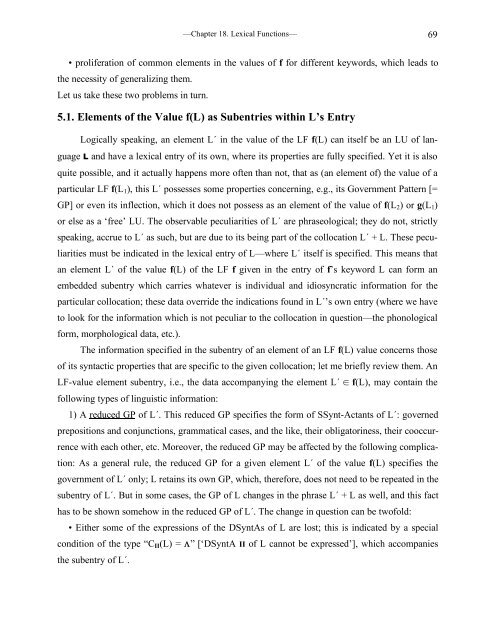
![E-Mail: Wolfgang.Schindler[ätt]germanistik.uni-muenchen.de Web ...](https://img.yumpu.com/51590147/1/184x260/e-mail-wolfgangschindlerattgermanistikuni-muenchende-web-.jpg?quality=85)
